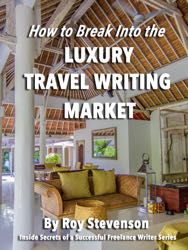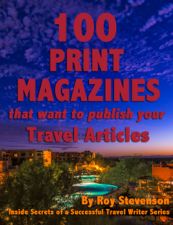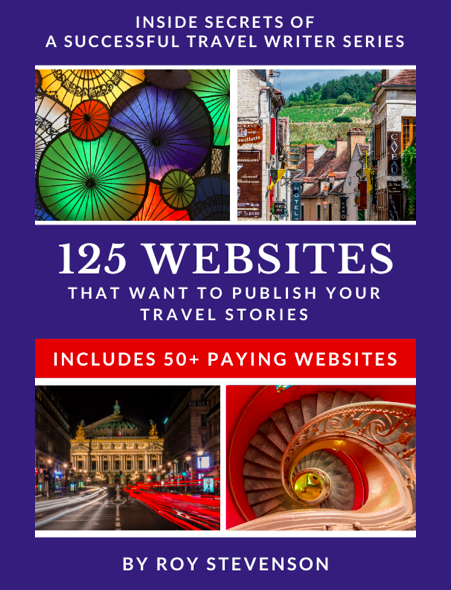- Home
- Query Letters
- Best Query Letter Checklist
Best Query Letter Ever
Use This Checklist Before You Hit “Send”.
By Roy Stevenson
The best query letters are the flashpoint where we present
our story idea and convince editors they're worthy of being published.
Your query letters aren’t the only factor that determine your freelance writing success, but they're a critical element for selling your story. It’s where the rubber meets the road.
Many new freelance writers fear query letters. There are so many ways you can make mistakes!
For example,
- Are you sure you covered everything?
- How much (or how little) information should you cram into your letter?
- Do you wonder if you’re overselling your idea?
- Are you under-representing your story idea — and yourself?
Certain elements are expected in all good queries. But, miss one or two of these elements, and you'll probably fail.
That’s where my query letter checklist enters the picture. This tool will quickly assess if you've written the best query letter. It ensures you haven’t missed any crucial bits and pieces.
Queries are like a jigsaw puzzle that might be missing a few pieces. Those little bits and pieces often make the difference between selling your story or getting rejected by an editor.
This checklist isn’t meant to be an in-depth analysis of the important components in a query. That’s covered that in our book, The Complete Guide to Query Letters for Travel Writers.
Instead, this handy list will tell you whether you’ve missed any of the twenty two vital ingredients. Armed with this knowledge, you can go back and beef up the sections you’ve shortchanged or completely missed.
Since 2007 I’ve sold more than 1,000 articles to over 200 regional, national, and international magazines, newspapers, trade journals, custom publications, specialty magazines, in-flights, on-boards, and online travel magazines. This means that I’ve sent out over 1,000 query letters that resulted in getting my stories published.
And I sell more than 90% of the stories I pitch. Most veteran freelance writers consider they’re doing well if they sell 25% to 40% of the stories they pitch. I’m clearly doing something right with my query letters – and it’s been my area of expertise for several years.
Beyond my own freelance writing experience, I’ve also learned a tremendous amount about query letters from coaching and mentoring my clients. After six years and over a hundred clients, I’ve learned a lot about what it takes to write the best query letters.
Some mistakes I've seen coaching clients make would have cost them the sale of their stories if I hadn’t been the “human checklist” looking over their shoulder and giving them feedback before they hit “send”.
After I've vetted their queries, virtually all my aspiring travel writers have had their
stories published in respected, paying print magazines. This checklist documents the things I look for during my review.
If you use this list before you hit “send”, you’ll see your acceptance rate rise noticeably.
To Use This Tool:
1. Write your draft query letter.
2. Compare your draft letter with each item in the checklist.
3. Go back and address any sections where you missed the mark.
4. After you’ve done a thorough review and made the corrections, you can feel comfortable that you've written the best query letter and can finally hit “send”.


 |
Are your contact details (name, address, phone number, email address, & website URL) listed at the top in standard business letter format? |
 |
Did you put a date at the top of your letter? (Place it above or directly below contact details.) |
 |
Did you address the letter with the editor's name? Did you spell the editor's name correctly? |
 |
Did you insert the correct name of the magazine? Did you spell the name of the magazine correctly? |
 |
For the best query letter, did you include a compelling title or story headline after your contact details? |
 |
Was your first sentence and paragraph dramatic enough to hook the editor to read the rest of your query? |
 |
Are you presenting an identifiable story angle? For the best query letter, your story angle should be unique. |
 |
Do your lead sentence and your lead paragraph clearly state your proposed story idea? |
 |
Have you included some interesting facts and statistics about your destination to show you have knowledge of the place? |
 |
Have you included proof you’re the right person to write this story? i.e. a credentials paragraph that shows why you’re qualified to write for this magazine? |
 |
Did you show how your proposed article is relevant and suitable for the magazine’s readership? Is the destination or attraction relevant to this magazine? |
 |
Did you include clips or links to some of your previously published stories? |
 |
Did you thoroughly proofread your letter? Did you run a spelling and grammar check? |
 |
Did you mention how many words your story will be? Did you give a range? The best query letters include a range. |
 |
Did you mention that you reviewed the magazine’s submission guidelines? |
 |
Are you planning to submit photos with your article? Have you mentioned this? |
 |
Did you include your social media sites, # of friends, followers or other relevant statistics? |
 |
Was your final sentence a call to action? Was it polite and not pushy? The best query letters are polite and professional. |
A Few More Hints for the Best Query Letter
Subject line of your email:
Don’t state the proposed title of your article in the subject line. You want the editor to open your email to find out more about your query. When you place your topic in the subject line, the editor may prejudge it and hit “delete” without reading your letter.
I use “Query re Article for XXX Magazine From Travel Writer Roy Stevenson”. This piques the editor’s curiosity and causes him to open the email. Then I rely on the query letter itself to get him hooked.
Length of Your Query Letter
Make your query long enough to explain your story idea well. Many experts recommend a short letter of just a few paragraphs. I totally disagree with this.
In my experience, editors commission articles from queries that go into some detail about the topic. Many of my queries are two pages long.
From coaching and mentoring observations, the writers who send brief queries tend to get the poorest response from editors. Therefore, make your query long enough to provide crisp, clear information about your story idea. But don’t ramble or bore the editor to the point of insensibility.
Editors generally prefer articles about a narrow aspect of a destination, versus a roundup. But, if your target magazine accepts roundups, you’re perfectly entitled to pitch wider, more “panoramic” stories.
Your Story Idea and Fit
Are you sure the destination or attraction is appropriate for the magazines you’re pitching? Don’t pitch a luxury story to a budget magazine (or vice versa), for example. Make sure you’re targeting the right audience for your topic.
Send Clips and Links
I send editors one link to my writer’s website, which has a portfolio of some of my articles. If you have a writer’s website this is by far the easiest and cleanest way to send them to your portfolio.
Word Count of Proposed Story
Give a word range (e.g. 800-1200 words). Mention that you’re happy to write the piece according to the editor’s word preference.
I’ll often write a sentence like this: “Your submissions guidelines state that you prefer articles 500-800 words, and I can easily meet this requirement.”
Asking for the Sale
Before you close your letter, you need to ask for the sale without being too pushy. For example, I close with: “Thank you for consideration of this article. Please contact me if this piece looks like a good fit for your magazine. I look forward to hearing from you at your convenience.”
There's no need to struggle with writing a query letter.
Here's a guide that tells you everything you need to know, along with 20 sample query letters that you can use as templates to help you write your own queries.
It's a steal at less than $20.
Related articles that will interest you:
Query Letter Guide: 7 Tips for Travel Writers
The Brighter Side of Rejection Letters
Writing a Query Letter Resource Page

Roy Stevenson is a professional travel writer and the author of www.PitchTravelWrite.com. Over the past ten years, he’s had more than 1000 articles published in 200 magazines, trade and specialty journals, in-flights, on-boards, blogs and websites and has traveled on assignment around the U.S. and to dozens of international destinations.
IF YOU ENJOYED THIS POST, GET UPDATES. IT'S FREE.














